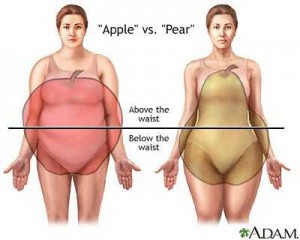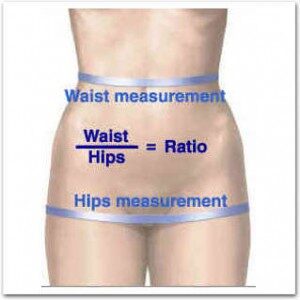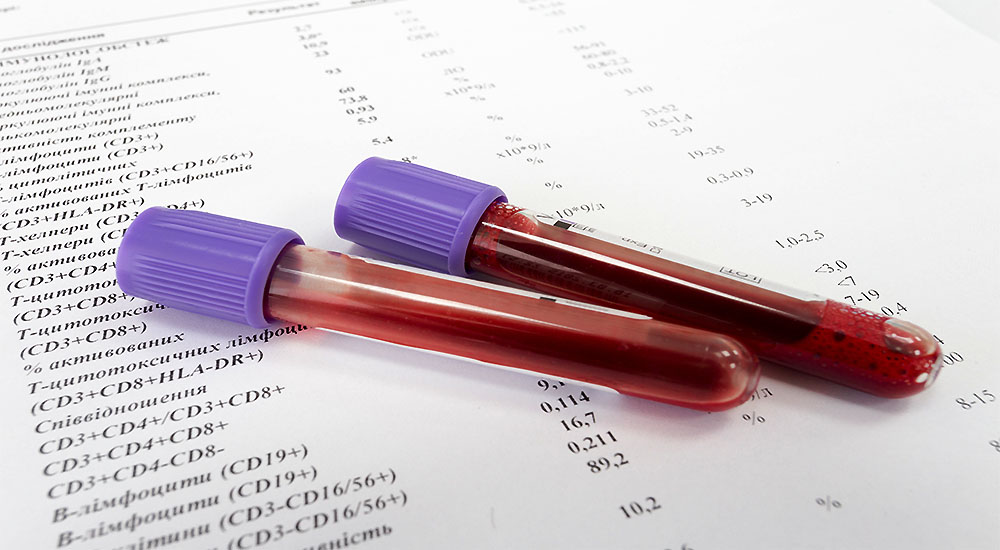Are You an “Apple” or a “Pear”? Learn Your Heart Disease Risk

Are You at Risk for Heart Disease, Diabetes, and More?

Is Your Fat Killing You?
Does that sound dramatic? Believe me, it isn’t. And if you don’t consider yourself overtly fat but you still have a belly, you’re not out of the woods. You may very well fall into the category of ‘skinny fat’ – not overweight, but still over-fat and therefore still at increased risk of what we call ‘Metabolic Syndrome”, a condition that increases your risk of several diseases including heart disease, diabetes, dementia, polycystic ovarian disease, liver and kidney disease.
As you know, heart disease is the number one leading killer of all Americans, men, and women alike. What you may not know is that changes in the body consistent with the development of heart disease are present in our children as young as 9 years old! Are we ‘winning the war’ against heart disease? Far from it! We are failing miserably.
Where to Begin
You are never too young to check the following numbers and we can definitely assist you here at our clinical nutrition department to get all the information you need to begin a program that can reverse metabolic syndrome.
1. Determine your waist to hip ratio. Get a soft tape measure and measure the waist and hips. The waist is found between the bottom of your rib cage and the top of your hip bone. Exhale when you take the measurement. The hip measurement is taken at the level of the trochanter – the bump of bone on the outside of your thigh bone – this should be your widest part in the area of your hips.

As an example, a woman who’s waist is 27 inches and her hips are 36 inches would have a ratio of 0.75 (27 divided by 36), a healthy ratio making her a pear shape. But a woman with a waist of 33 inches and hips of 36 inches would have a ratio of 0.91, an unhealthy apple ratio, indicative of metabolic syndrome.
3. Discover what your blood fat numbers are. Am I simply talking about cholesterol? Actually no. If cholesterol was the only number we needed to know, then 50 to 75% of people who have a heart attack wouldn’t have normal cholesterol. That’s right. The majority of people who have heart attacks have normal cholesterol numbers!
Am I talking about HDLs (good cholesterol) and LDLs (bad cholesterol)? Yes and no. It turns out the most of these basic numbers that you receive from your annual physical are pretty worthless. The truth of the matter is that we need to delve deeper into these numbers to get the real picture of what’s happening in our bodies and if we need to radically change our lifestyle in order to prevent heart disease.
Research also shows that a quite high HDL (supposedly our good cholesterol) is a bad thing. Normal is good but high means inflammation, a very high-risk factor for heart disease and other degenerative diseases.
If you want to test your doctor’s cardiac risk knowledge ask him or her to test the SIZE of your cholesterol. If your doctor gives you a blank stare it’s time to find a new one.
I’m not trying to be harsh here but heart disease is the number one killer of all Americans. The odds are very good that you will get this disease and unfortunately, the odds are pretty good that you already have it ‘brewing’ to some degree or another. (Don’t get depressed, it can be reversed. Read on…). The point is that if you are at risk due to obesity or family history, you owe it to yourself to find a doctor who will do the right testing for you.
It turns out that when it comes to the size of cholesterol, big particles are ‘safe’ and small particles are ‘dangerous’. If you don’t know this you could have a normal total number but still, be at risk because the particles are of a dangerous size. How do you get this information? It’s a blood test, just not the one you typically get. The laboratory has to have the ability to determine particle size.
This technology is not new, by the way. We’ve been using it here at our clinic for at least 5 years if not longer. The technology always made sense to us but recent research has absolutely confirmed that such testing must be an integral part of working with patients who are at risk for metabolic syndrome. Therefore we will be doing this test much more often now.
4. Learn your triglyceride number and do a ratio between it and HDLs (good cholesterol). Less than 3 is normal, greater or equal to 3 is suggestive of insulin resistance and metabolic syndrome, a condition that leads to diabetes and heart disease, not to mention obesity.
5. Find out your CRP number. This is commonly tested for in standard blood tests, so just get a copy of your test. A high CRP is indicative of inflammation and is a strong predictor of heart disease.
6. Speaking of inflammation, another test you can ask for is Lp – Pla2. The higher the number the more likely your arteries are inflamed and the greater the likelihood of your plaque rupturing – a very bad thing.
What Should You Do if You’re at Risk?
First, find a doctor who is truly knowledgeable in this area. Much like one of my favorite topics, celiac disease, and gluten intolerance, heart disease suffers from antiquated data and protocols that simply do not work anymore. As I mentioned, we are more than happy to be a resource for you here at Root Cause Medical Clinic.
Second, work towards addressing what is estimated to cause 75 to 80% of all heart disease – chronic infection and chronic inflammation. Experts in the field who are cutting edge, agree that if we properly addressed these two issues, we could factually handle 8 out of 10 people suffering from heart disease. Sound amazing? I know, but it’s still true.
The successful treatment protocols that get to the root cause of infections and inflammation are dietary and lifestyle based, not drug-oriented. When omega 3 fatty acids (fish oils) were compared with statin drugs, as an example, the fish oils showed a 32% reduction of heart disease while the statin drugs such as Lipitor showed a mere 22% reduction, and they have dangerous side effects that fish oils do not. Even LDL, the supposedly bad cholesterol, isn’t actually bad until the inflammation comes along and alters it.
Lastly, find a clinician who knows how to test for ‘hidden’ chronic infections and is comfortable working with and remedying inflammation. This doctor should speak confidently about dietary and lifestyle changes and the vast amount of success he or she has seen with the program they use.
This is an area that we’ve been addressing for well over a decade. I don’t mention this to ‘blow our own horn’, it simply is the fact. Wider acceptance of the link between infection, inflammation, and disease is something we’ve been waiting a long time to see occur – it finally has.
This data is not new. The research is not new. Why aren’t more people discussing it? Unfortunately, we live in a drug and pharmaceutical-driven society that would much rather pop a pill than change their diet.
The fact that the former doesn’t work and has dangerous side effects, while the latter is completely safe and works, seems to be beside the point. Well in fact it IS the point, and here at Root Cause Medical Clinic, we are tired of seeing the statistics of death associated with metabolic syndrome continue to increase when it’s so preventable and treatable with food, not drugs, for the most part.
Here’s a Recommended Book
To learn more about this topic I suggest you read the following book: “What Your Doctor May Not Tell You About Heart Disease” by Dr. Mark Houston, MD. Dr. Houston is a cardiologist and Associate Clinical Professor of Medicine at Vanderbilt University School of Medicine, as well as the Director of the Hypertension Institute and Vascular Biology at Saint Thomas Medical Group, Saint Thomas Hospital in Nashville, Tennessee.
We Have a Program that Works
If you would like to begin a program to change from an apple to a pear, contact me. Please do not be shy about this. We are here to help and are happy to offer a free health analysis to you, your friends, and your family.
Do you need help with your health?
We have the diagnostic and testing tools, the clinical experience, and a different medical approach to discovering the root cause of why you have the symptoms that are bothering you. As long as you are ready to make some dietary and lifestyle changes, we can help you. We will "hold your hand" through the changes, step by step, to make each step an easy one. We are located in Clearwater, FL, at 1000 S Ft Harrison, at the corner of Ft. Harrison Ave. and Magnolia St. There is plenty of parking space directly accessible from Ft Harrison. If it is not convenient for you to come to Root Cause Medical Clinic, we offer telehealth/telemedicine consultations to residents of certain states. Call us for details.
Contact us for a Consultation – Call 727-335-0400

Dr. Vikki Petersen DC. CCN
Founder of Root Cause Medical Clinic
Certified Functional Medicine Practitioner
Dr Vikki Petersen is a public speaker, author of two books, several eBooks and creates cutting edge content for her YouTube community. Dr Vikki is committed to bringing Root Cause Medicine and its unique approach to restoring health naturally to the world.
Ask a Doctor
Have a health concern you'd like to speak with a doctor about? Or just want clarity on a subject? Ask Us!


